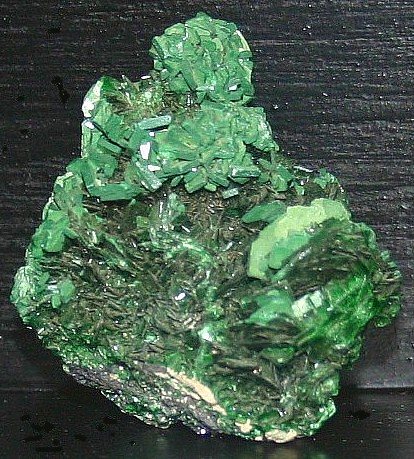|
.
Torbernite
Mineral Facts:
Chemical
Formula: Cu(UO2)2(PO4)2
- 8H2O
Hydrated
phosphate of copper and uranium.
Colors:
Black color
with brownish tinge, black streak.
It
is strongly pleochroic in green and blue.
Hardness:
2 to 2.5
Density:
3.4 to 3.6
Cleavage:
One perfect cleavage on 001.
Crystallography: Tetragonal.
Torbernite occurs in
small square tables, that may be very thin or moderately thick, and the
crystals are extremely simple in form. It also occurs in foliated and
micaceous masses.
Luster:.
Subadamantine, pearly on cleavage planes;
transparent to subtranslucent..
|
 |
|
Composition, Structure and
Associated Minerals:
Torbernite has a perfect clevage parallel to the basal plane, giving
extremely thin lamellae, and in this respect resembling mica, whence the
name uran-mica, by which the mineral is sometimes called. The laminae are
brittle and not flexible, and in this respect they differ from the laminae
of mica minerals. Like all uranium minerals, it is radioactive and emits
small quantities of toxic radon gas, so reasonable precautions should be
taken in handling and storing it.
Torbernite is isostructural with the related and more
common calcium uranium phosphate mineral,
autunite.
Identification
and Diagnostics
The
mineral is bright green in emerald, grass or apple shades, has a lighter
green streak.
Torbernite gives reactions for Cu and P and yields water in the closed tube.
The bead reactions for uranium are masked by those of copper. The mineral is
soluble in HNO3. The mineral is easily recognized by its color and other
physical properties.
Localities
Torbernite is occasionally found as a coating on the walls of crevices in
rocks. It occurs in Cornwall, England; at Scheeberg, Germany; at
Joachimsthal, in the Czech Republic, and at many other places where other
uranium minerals exist. It is probably in all cases a secondary product of
weathering. Containing 61.2 per cent uranium trioxide, it is a minor ore of
uranium. Attractive coloration and crystallization make it desirable as a
mineral collector specimen.
.Return
to the
Mineral Collectors Information Page |
|


